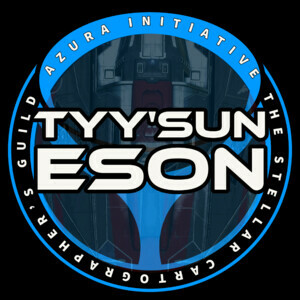Whambeia Sector Report (Explorer's Guild)
03 May 2021Tyy'sun Eson
Whambeia Sector ReportFleet Carrier TFS Quantum Harmonic arrived in the Whambeia sector a week ago on a mining expedition during the return trip to the bubble from the conclusion of the ‘In Search of Gwydion’ expedition. Reserves are reportedly high enough for the trip, but the captain Michael Rhodes is rightfully lured by promising yields of tritium and Tyy’sun Eson took the opportunity for a few excursions into the sector for exploration. The sector represents a nice cross section of the edge of the Galactic Bar as it extends out into it’s armatures. After several flight sessions in the Anaconda: Cuatator de Avadar a region of visited stars began to grow on the star map and a more comprehensive survey of this area was possible. Notable pilots joined the excursions in organized wings allowing for a total of 100 systems to be explored before TFS Quantum Harmonic departed into the Norma Arm, resulting in this report.

In a word: Violent. The region runs thick with hydrogen gas clouds and radiation from a thousand former novas, the entire star field littered with neutron stars and their high energy gamma ray emissions, black holes, white dwarfs and red giants undergoing expansion. Dotted around these are chaotic young stars undergoing system formation, O class, A Class, B Class, and T Tauri upstarts seeking the main sequence, and of course the normally present host of main sequence classes painted in between. It is not a wonder to the scientists on board why there are no biological signals to be detected on the many rocky and atmosphere-less moons surrounding gas giants. These environments show the wear and tear of the region of the galaxy they inhabit. Not immune to the turbulence of the Galactic Bar, one specimen is merely an irradiated core of a former gas giant (PZ-0 e6 1859 A 7), exposed and naked, hanging awkwardly with a set of 6 standard moons, also airless:


The core features few craters, though the ones it does feature either attest to the age of the core, dating back to the formation of the star system itself, or to the length of time the core has been without it’s gas giant atmosphere. Further analysis of the surface samples will be needed for a more accurate determination. The rare opportunity to study the surface of a gas giant was too interesting to pass up. Although no significant geological activity could be found on the surface during initial scanning, and no volcanic activity at all, the topography of the surface proved interesting: featuring a goose-bump like appearance from orbit, with what are giant mounds of formerly compacted metals and rock under the extreme pressures of the former atmosphere, now exposed for study. The lack of any volcanism is attributed to the density with which the materials of the core have been packed tightly into a metallic near solid. Only a lack of ices and water have saved the planet from the typical glacial appearance of worlds so far from their parent star. Soon after the discovery and detailed surface scan of the former gas giant core, Captain Michael Rhodes aided in the research by consulting his extensive data troves from past exploration. Though a complete analysis could not be conducted due to technical problems, it was determined that the configuration itself of high metal content worlds without atmosphere and six moons, positioned deep in the system where gas giants normally roam is indeed a rarity worth noting.


Despite the hostility of the Galactic Core, and perhaps as a result of Captain Rhode’s route slightly elevated to the galactic plane, a few pristine pockets of tranquility have managed to persist in the Whambeia sector. In the 100 systems surveyed, 4 Earthlike worlds, two Ammonia worlds and a host of water worlds were cataloged at the Universal Cartographics laboratories on board both Tyy’sun Eson’s ship, and the Quantum Harmonic. These discoveries were enabled by the pooling of resources and wing flights by the newly formed ‘Explorer’s Guild’. Contributions to this report were made by CMDRs Michael Rhodes, Heart Symbol, Delta Green 11 and Tyy’sun Eson with Eson organizing the survey and compiling the report.
The only biological signals located in the entire survey were from a lone gas giant harboring ammonia radioplankton in distant orbit of a neutron star (FZ-D d13-1164 4). The surprising development does attest to the perseverance of biological processes in even the most hostile environments. Life finds a way. Then again, it’s rarity and the lack of more complex biological signals also attests to the sheer levels of regional activity from the Galactic Bar in Whambeia Sector. Of final note is the Red Giant dominating the central area of the survey, it's expanding size soon to envelope the region in yet another nova, sloughing off it's metals and corona into the stellar winds and hydrogen gas of the Galactic Bar.



